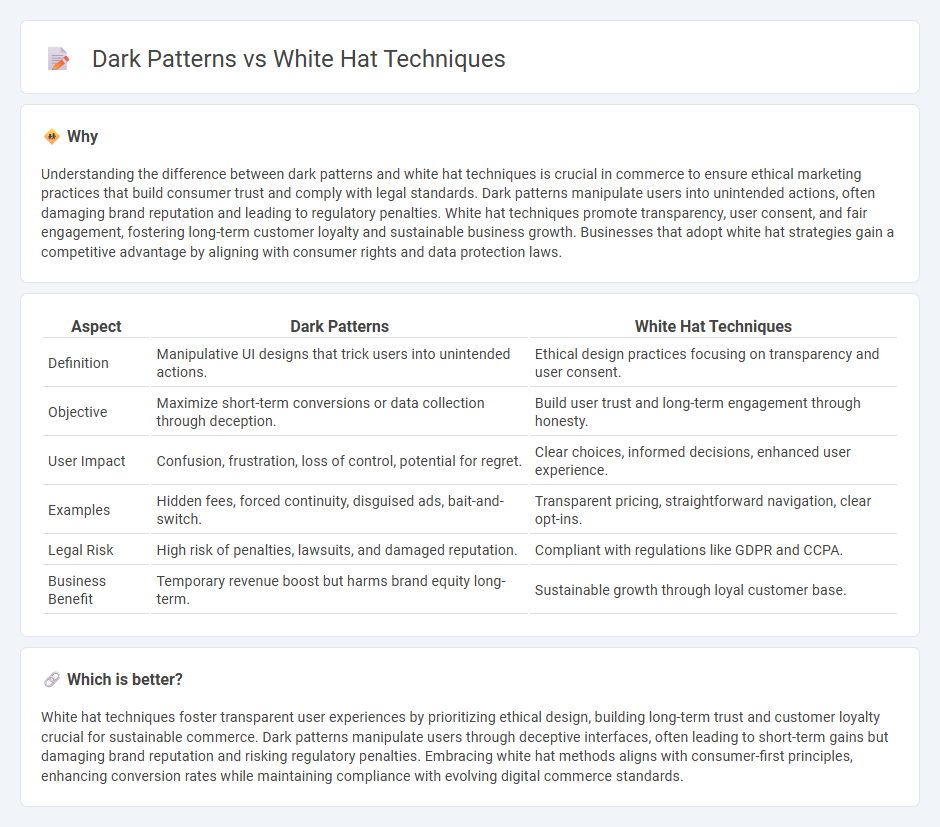
Commerce strategies often employ contrasting approaches such as dark patterns and white hat techniques, each influencing user behavior differently. Dark patterns exploit psychological manipulations to deceive users into unintended actions, while white hat techniques enhance user experience through transparency and ethical design. Explore these techniques further to understand their impact on consumer trust and business success.
Why it is important
Understanding the difference between dark patterns and white hat techniques is crucial in commerce to ensure ethical marketing practices that build consumer trust and comply with legal standards. Dark patterns manipulate users into unintended actions, often damaging brand reputation and leading to regulatory penalties. White hat techniques promote transparency, user consent, and fair engagement, fostering long-term customer loyalty and sustainable business growth. Businesses that adopt white hat strategies gain a competitive advantage by aligning with consumer rights and data protection laws.
Comparison Table
| Aspect | Dark Patterns | White Hat Techniques |
|---|---|---|
| Definition | Manipulative UI designs that trick users into unintended actions. | Ethical design practices focusing on transparency and user consent. |
| Objective | Maximize short-term conversions or data collection through deception. | Build user trust and long-term engagement through honesty. |
| User Impact | Confusion, frustration, loss of control, potential for regret. | Clear choices, informed decisions, enhanced user experience. |
| Examples | Hidden fees, forced continuity, disguised ads, bait-and-switch. | Transparent pricing, straightforward navigation, clear opt-ins. |
| Legal Risk | High risk of penalties, lawsuits, and damaged reputation. | Compliant with regulations like GDPR and CCPA. |
| Business Benefit | Temporary revenue boost but harms brand equity long-term. | Sustainable growth through loyal customer base. |
Which is better?
White hat techniques foster transparent user experiences by prioritizing ethical design, building long-term trust and customer loyalty crucial for sustainable commerce. Dark patterns manipulate users through deceptive interfaces, often leading to short-term gains but damaging brand reputation and risking regulatory penalties. Embracing white hat methods aligns with consumer-first principles, enhancing conversion rates while maintaining compliance with evolving digital commerce standards.
Connection
Dark patterns manipulate user behavior through deceptive design to increase sales, while white hat techniques prioritize ethical strategies that build trust and long-term customer loyalty in commerce. Both approaches influence consumer decision-making, but white hat methods emphasize transparency and respect, enhancing brand reputation and sustainable growth. Leveraging user experience insights helps businesses transition from harmful dark patterns to effective white hat strategies that optimize conversion rates responsibly.
Key Terms
Ethical Marketing
Ethical marketing emphasizes transparency, honesty, and user respect, employing white hat techniques such as clear consent forms, truthful content, and data privacy safeguards to build trust and long-term customer relationships. Dark patterns, by contrast, manipulate users with deceptive UI designs, hidden fees, and misleading calls-to-action that prioritize short-term gains at the cost of user autonomy and brand reputation. Explore more about how ethical marketing strategies can enhance brand integrity and customer loyalty.
Consumer Manipulation
White hat techniques prioritize transparency and user consent, utilizing ethical design practices that enhance consumer trust and provide clear, honest information to aid decision-making. Dark patterns exploit cognitive biases and manipulate user behavior through deceptive interfaces and hidden opt-out options, leading to uninformed or unintended consumer actions. Explore how ethical UX design mitigates consumer manipulation and fosters genuine engagement.
Transparency
White hat techniques prioritize transparency by clearly informing users about data collection, usage, and providing genuine choices, ensuring ethical interactions and trust. Dark patterns manipulate user decisions through hidden information or deceptive design, obscuring transparency and exploiting user behavior for unfair advantage. Explore detailed strategies to enhance user trust through transparency in ethical design practices.
Source and External Links
White Hat Techniques in SEO - Now Media Group - White hat SEO involves optimization that complies with search engine guidelines by focusing on quality content creation, natural keyword research, and thorough on-page optimization to enhance user experience and organic ranking.
White Hat SEO: The Definitive Guide - Backlinko - Key white hat techniques include the Skyscraper Technique, which improves upon top-ranking content, and broken link building, which involves suggesting your site as a replacement for dead links on other websites.
What Is White Hat SEO? 5 White Hat SEO Techniques - Shopify - Essential white hat SEO practices are publishing high-quality valuable content, including relevant keywords naturally, earning backlinks ethically, optimizing for user experience, and configuring crawler settings properly.
 dowidth.com
dowidth.com